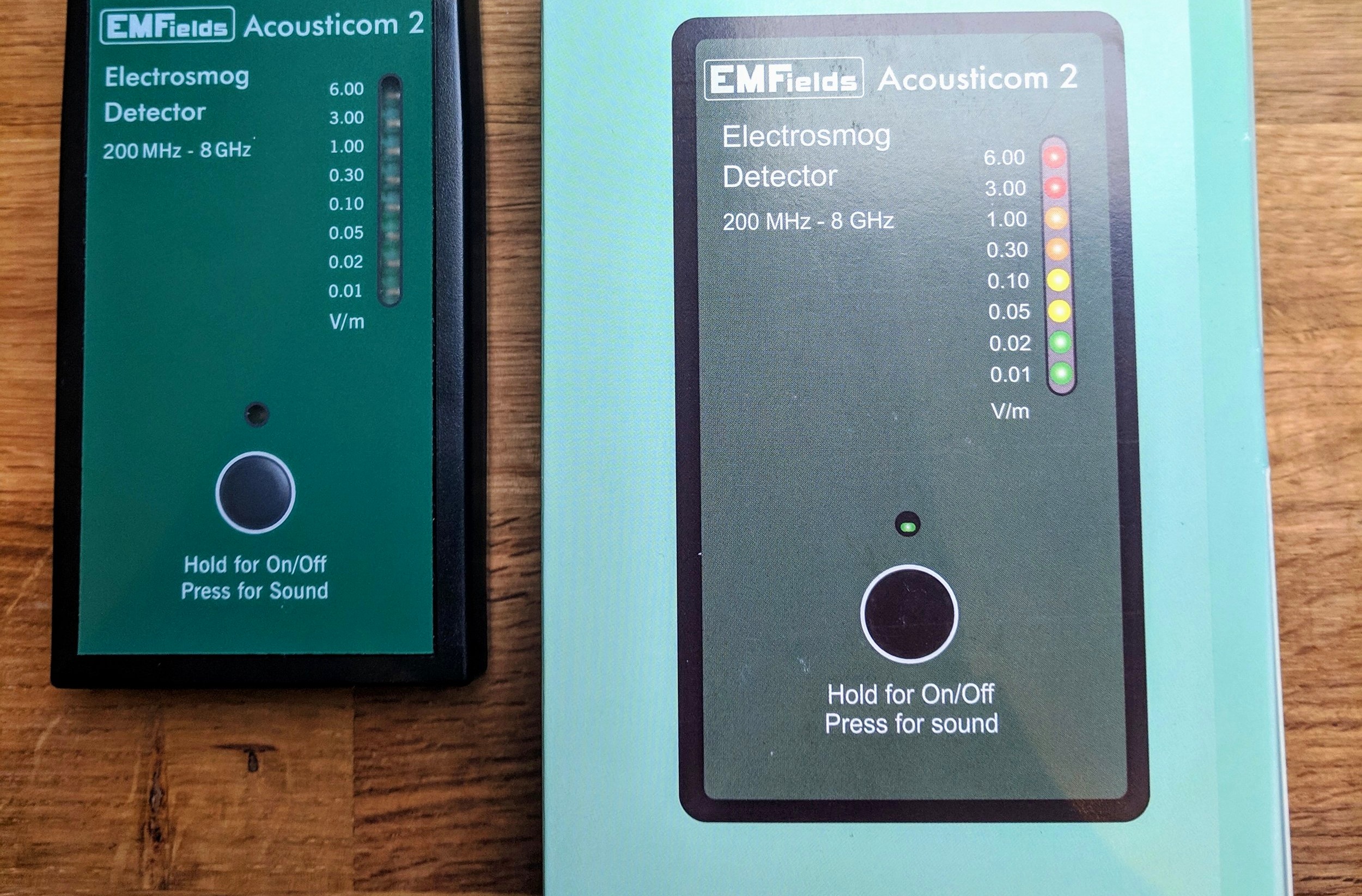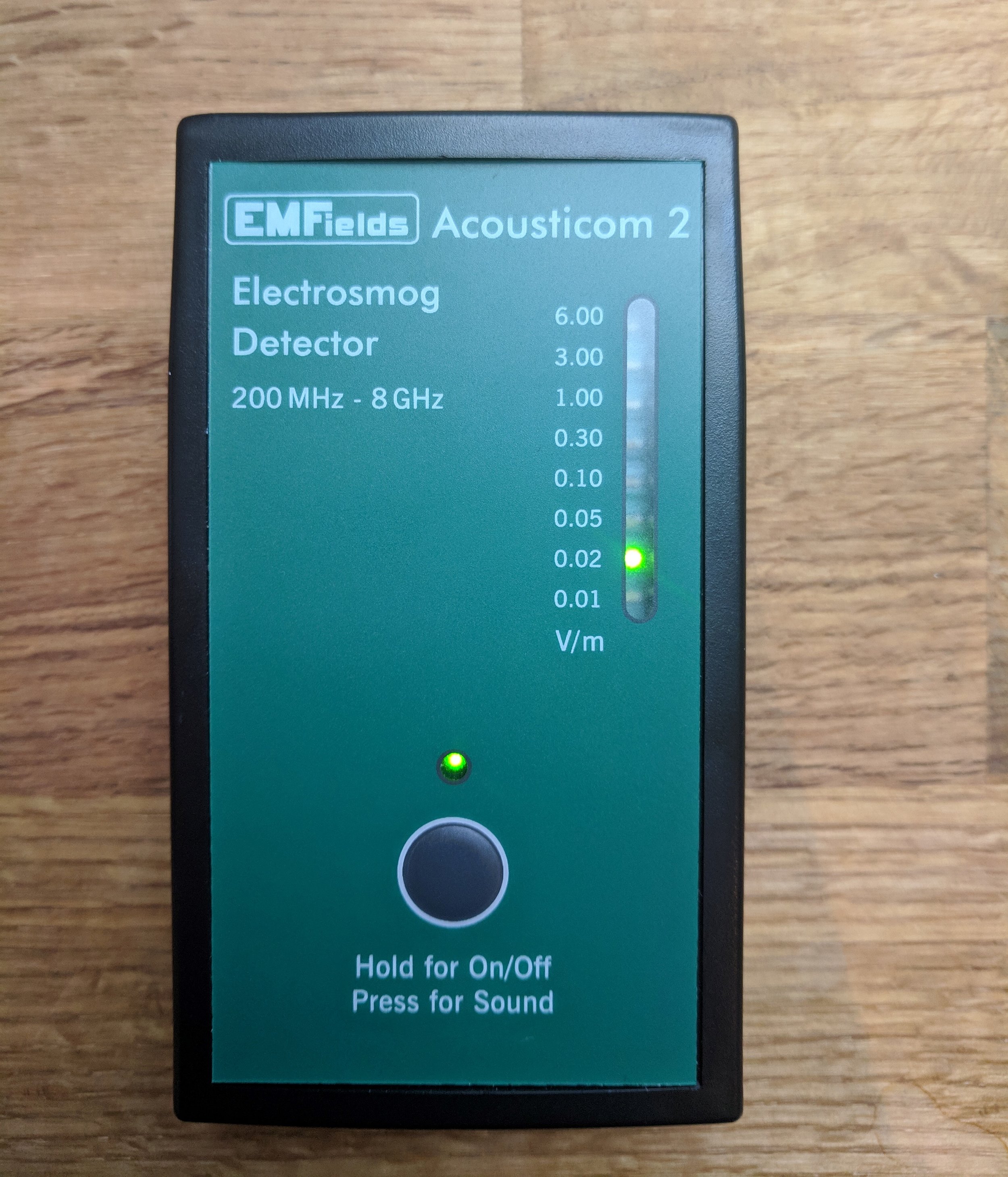We’ve heard a lot of positive things about the Acousticom 2 and over the past few days we’ve been testing it out. Like many others, we have a lot of praise for the small but powerful radio frequency (RF) / microwave meter. EMFields, the creators, are based in the UK where we are and we love that they manufacturer the meters here too. Here’s some of the things you can detect using the Acousticom 2:
Cordless phones, WiFi router/modems, smart meters, mobiles phones, Playstations and other wireless video games, digital baby monitors and smart TVs.
Design & Functionality
The Acousticom 2 is extremely portable, coming in at 140g (inc battery) with a LxWxD of 110 x 63 x 21 (mm) meaning it fits perfectly in the hand. The meter comes with a battery and has a life of up to 10 hours continuous with a normal alkaline battery. It also comes with a small carry pouch which means you can take it on the go with you.
As with other meters, it has an acoustic signal to better identify the source of radiation which can be switched on and off using the single button on the front. The real standout feature about this device is the LED light system which goes from green to red depending on the reading. The light system is particularly beneficial for those getting started in electromagnetic pollution who might not understand the implications of specific readings. Two colours will light up on the meter if the reading falls between two values as you can see in the picture below. This really separates it apart from other meters on the market as you can very quickly identify areas of concern.
Green reading: 0.02 V/m
Yellow/orange reading: 0.10 - 0.30 V/m
Stats
Measurement range: 200 - 8 000 MHz ±6 dB (typical accuracy)
Sensitivity (Peak Display): 0.01 - 6.00 volts per metre (V/m)
0.01 0.02 0.05 0.1 0.3 1.0 3.0 6.0 V/m; (equialent to 0.5 to 100,000 peak µW/m2)
Power draw: 40 to 90 mA (depends on the sound volume)
Using the meter
Unlike other RF meters which sometimes use units like milliwatts to measure RF, the Acousticom 2 uses V/m, which is an equally reliable measurement in detecting RF signals. The meter reacts very quickly to the pulses of RFs and provides you with the peak readings which is the highest sampled reading. You won’t find an average reading on this meter, however the peak reading is really the most important to detect because wireless technologies typically emit frequent bursts of RFs. Although we would of liked to have seen a digital display, this isn’t the aim of this meter or rather detector. The Acousticom 2 is all about keeping the measurement easy to understand.
To use the meter, simply switch the meter on pressing the black button in the middle and wait a few seconds for it to gauge the reading. Perhaps the best part of this meter is that it can pick up on such a wide range of frequencies, from 200 MHz all the way up to 8 GHz which makes it fairly future proof for the time being. Currently a lot of high frequency meters on the market only go up to around 3 or 4 GHz but the Acousticom 2 has the extra high range covered. This means you can comfortably measure TETRA, all mobile phone systems including 4G/LTE, Smart Meters, and all WiFi and WiMax frequencies.
When using the meter, you will be hard pressed to find many areas are in the green range (0.01 - 0.02 V/m) given the the huge growth of cell towers and WiFi. We found our readings to be floating in the 0.10 - 0.30 v/m range a lot of the time.
Overall
EMFields are leading the way in the high frequency meter range and the Acousticom 2 is no exception. This is a great meter for those on a budget who might not be able to afford their higher range model, the Acoustimeter, but still want the same high quality RF detector. If you are suffering from a strong electromagnetic sensitivity then the Acousticom 2 is worth considering given its ease of use. However, if you’re looking for a high frequency meter that’s going to provide you with detailed readings then you may want to look into a more advanced meter.
EMF Home Team



